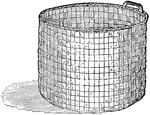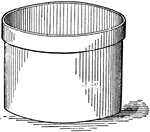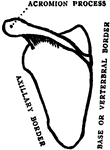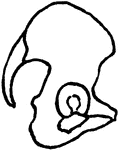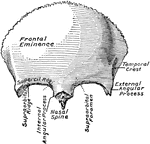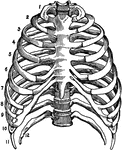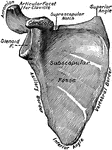
Hair-Cap Moss
"Hair-cap moss (Polytrichum commune). A, male plant; B, same, proliferating; C, female plant, bearing…

Monocotyledonous Morphology
"Morphology of typical monocotyledonous plant. A, leaf, parallel-veined; B, portion of stem, showing…

Mountain Laurel
"Mountain laurel (Kalmia latifolia). a, stamens in their original position, with the anthers in the…
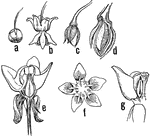
Milkweed Stages
"Milkweed (Asclepias sp.). a, flower-bud; b, flower; c, very young pod; d, older pod in section, showing…
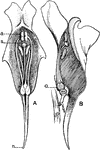
Common Toadflax
"Sections of flowers of the toad-flax (Linaria vulgaris). A, front view; a, anthers; s, stigma; n, nectar-gland.…

Embryo Chick
Embryo chick (36 hours), viewed from beneath as a transparent object (magnified). Labels:pl, outline…
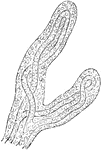
Magnified View of Chorion Villi
Very soon after the entrance of the ovum into the uterus, in the human subject, the outer surface of…

Uterus at Seventh Week of Pregnancy
Diagrammatic view of a vertical transverse section of the uterus at the seventh week of pregnancy. Labels:…
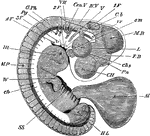
Embryo Chick at Fourth Day
Embryo chick at fourth day, viewed as a transparent object, lying on its left side. CH, cerebral hemispheres;…

Head of an Embryo
A, Magnified view of the head and neck of a human embryo of three weeks. Labels: 1, anterior cerebral…

Development of the Brain
Early stages in development of human brain. 1, 2, 3, are from an embryo about seven weeks old; 4, about…

Fetal Brain at Six Months
Side view of fetal brain at six months, showing commencement of formation of the principal fissures…
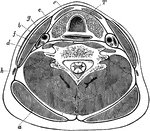
Transverse Section of the Neck
Transverse section through the lower part of the neck, to show the arrangement of the cervical fascia.…
Parallel Prisms
Types of parallel prisms: right triangular prism, isosceles triangular prism, rectangular prism, cylinder.
Oblique Prisms
Types of oblique prisms: right triangular prism, isosceles triangular prism, rectangular prism, cylinder.
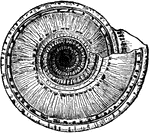
Solarium Perpectivum (Bottom View)
"The Staircase-shell is recognized by its deep umbilicus, wide and funnel-shaped, in the interior of…

Solarium Perpectivum (Side View)
"The Staircase-shell is recognized by its deep umbilicus, wide and funnel-shaped, in the interior of…

Egyptian-Front of Temple of Isis at Philae
This temple is at the southern end of the Great Temple in Philae. The temple was dedicated to the worship…
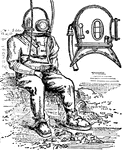
Diving-dress and diving-helmet
The diving dress in a rubber suit with a metal helmet, having pieces of glass in front to enable to…
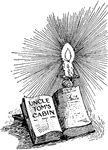
Uncle Tom's Cabin
The anti-slavery novel by Harriet Beecher Stowe was published in 1852 and had an effect on the view…
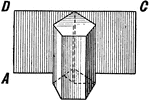
Surfaces Of A Prism
Illustration of a pentagonal prism showing, "If a piece of paper is fitted to cover the convex surface…

Surfaces Of A Cylinder
Illustration of a cylinder showing, "If a piece of paper is fitted to cover the convex surface of a…

Comparative Surfaces Of A Cylinder And Sphere
Illustration used to compare the surfaces of a cylinder and a sphere.
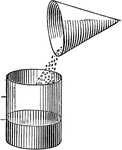
Comparative Volumes Of A Cone And Cylinder
Illustration used to compare the volumes of a cone and a cylinder by emptying sand from the cone into…

Comparative Volumes Of A Cone, Sphere, And Cylinder
Illustration used to compare the volumes of a cone, a sphere, and a cylinder.
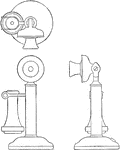
Orthographic Projection of Candlestick Telephone
Orthographic projection drawing of a candlestick or upright telephone. An orthographic projection is…
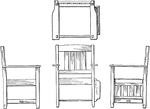
Orthographic Projection of Arm-Chair
Orthographic projection drawing of an arm-chair. An orthographic projection is the method of representing…

Orthographic Projection of Stairs
Orthographic projection drawing of stairs. An orthographic projection is the method of representing…
Helix
A cylindrical helix is a curve generated by a point moving uniformly around a cylinder and uniformly…

Position of the Pelvic and Thigh Bones in the Male and Female
Diagram showing the position of the pelvic and thigh bones in back view in the male and female.
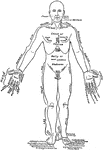
Front View of the Parts of the Human Body Labeled in English and Latin
Front view of a man in the anatomical position. On one lateral half the parts are labeled in English,…

Back View of the Parts of the Human Body Labeled in English and Latin
Back view of a man. On one lateral the names of the parts are given in English, on the other in Latin.
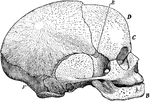
Side View of Fetal Skull
Side view of a fetal skull. The coronal suture extends from the top of the head downwards on either…

Lateral and Dorsal View of the Vertebral Column
The spinal column, right lateral view and dorsal view.




